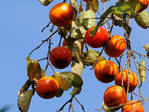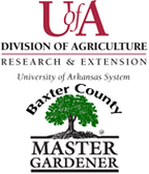|
Ozark Green Thumb BCMG Monthly e-Newsletter |
|
|
 I’ve always suspected that possums have that smirky grin because they are fantasizing about the coming persimmon feast. Country folk enjoyed the persimmon too. The mushy native fruit was a diversion from their humdrum diet. Our old friend, the persimmon, is a botanical trickster and folk who have fallen victim to its puckering ways hold grudges. The alternately arranged, ovate leaves are four to six inches long and gray-green in color. They may turn a yellow-brown in the fall but color production is unreliable. The bark of old trees is blackish with square, reptilian plates that give trees a handsome winter appearance. Persimmon flowers are white to yellow-green with four petals and sepals. Usually plants are dioecious with either male or female trees, but sometimes flowers of both sexes are found on the same tree. The flowers are not especially showy being small and mostly obscured by the leaves that emerge first. Considerable variability exists in persimmon fruit as to size, color, time of ripening and sensory characteristics such as texture, taste and sweetness. Four large sepals reflex from the top of the fruit, which is yellow, golden or orange in color and covered with a waxy bloom. The usual fruit is about the size of a golf ball-and according to non-believers -- about as tasty. Fruit ripening occurs from September through November with fruit hanging on the tree until early winter. Since the time of the rapid western expansion following the Civil War, agriculturists have been predicting that the persimmon is just on the verge of becoming an important fruit crop. But, alas, it didn’t happen then and it still hasn’t happened. It probably never will. While the Japanese and Chinese have developed over 1000 cultivars of a closely related species they call "kaki," only a few improved selections have been made of our native species. The first European to come into contact with the persimmon was Hernando DeSoto when he crossed the Mississippi River near Memphis in 1541. He found dried fruit and loaves of bread made from persimmon at the ancient Indian village of Casqui which is now the Parkin Archeological Park. Captain John Smith, the founder of the Jamestown colony in Virginia in 1607, wrote of the persimmon: "If it not be ripe, it will drawe a man’s mouth awrie with much torment. When it is ripe, it is deliscious as an Apricock." A uniquely Ozarkian legend has it that one can prophesy the severity of the coming winter by inspecting the seeds of the persimmon. Seeds are cut lengthwise to reveal the embryo suspended in a field of white endosperm. If the embryo is shaped like a knife, it will be a bitterly cold winter. If the embryo is spoon shaped, expect lots of snow. If it is fork shaped, a normal winter is in store. While most consider such prophecies as unfounded superstition, there may be some basis for the observation. If one assumes that summer weather patterns are a predictor of winter weather conditions, it is not illogical to reason that morphological changes could be reflected in the embryos of seeds formed during those summer months. About a dozen cultivars of persimmon are described and a few specialist nurseries offer them over the Internet or through their mail order catalogs. In the garden the persimmon is easily accommodated in about any sunny site. The fall webworm that produces the dirty gray webs in persimmons every fall are more ugly than harmful, a fact you should remember when they invade your tree. By: Gerald Klingaman, retired
Extension Horticulturist - Ornamentals Extension News - October 11, 2002
0 Comments
Leave a Reply. |
Archives
April 2022
|
|
